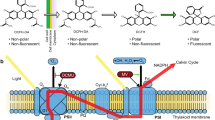Abstract
A new type of dual-channel PAM chlorophyll fluorometer has been developed, which is specialised in the detection of extremely small differences in photosynthetic activity in algae or thylakoids suspensions. In conjunction with standardised algae cultures or isolated thylakoids, the new device provides an ultrasensitive biotest system for detection of toxic substances in water samples. In this report, major features of the new device are outlined and examples of its performance are presented using suspensions of Phaeodactylum tricornutum (diatoms) and of freeze-dried thylakoids of Lactuca sativa (salad). Investigated and reference samples are exposed to the same actinic intensity of pulse-modulated measuring light. The quantum yields are assessed by the saturation pulse method. Clock-triggered repetitive measurements of quantum yield typically display a standard deviation of 0.1%, corresponding to the inhibition induced by 0.02 μg diuron l−1. Hence, for diuron or compounds with similar toxicity, the detection limit is well below the 0.1 μg l−1 defined as the limit for the presence of a single toxic substance in water by the European Commission drinking water regulation. The amounts of water and biotest material required for analysis are very small, as a single assay involves two 1 ml samples, each containing ca. 0.5 μg chlorophyll. Both with Phaeodactylum and thylakoids the relationship between inhibition and diuron concentration is strictly linear up to 10% inhibition, with very similar slopes. Apparent inhibition depends on the actinic effect of the measuring light, showing optima at 6 and 4 μmol quanta m−2 s−1 with Phaeodactylum and thylakoids, respectively.
Similar content being viewed by others
References
Conrad R, Büchel C, Wilhelm C, Arsalane W, Berkaloff C and Duval J-C (1993) Changes in yield of in-vivo fluorescence of chlorophyll a as a tool for selective herbicide monitoring. J Appl Phycol 5: 505–516
Genty B, Briantais J-M and Baker N (1989) The relationship between the quantum yield of photosynthetic electron transport and quenching of chlorophyll fluorescence. Biochim Biophys Acta 990: 87–92.
Joliot P and Joliot A (1964) Étude cinetique de la réaction photochimique liberant l'oxygène au cours de la photosynthèse. C R Acad Sci Paris 258: 4622–4625
Krause G and Weis E (1991) Chlorophyll fluorescence and photosynthesis: The basics. Ann Rev Plant Physiol Plant Mol Biol 42: 313–49
Merschhemke C and Jensen M (1993) Das FluOx-Algentestsystem. Ein automatisches Algentestgerät zur kontinuierlichen Gewässerüberwachung. Limnologica 23: 323–333
Merz D, Geyer M, Moss DA and Ache H-J (1996) Chlorophyll fluorescence biosensor for the detection of herbicides. Fresenius J Anal Chem 354: 299–305
Schreiber U (1986) Detection of rapid induction kinetics with a new type of high-frequency modulated chlorophyll fluorometer. Photosynth Res 9: 261–272
Schreiber U, Bilger W and Schliwa U (1986) Continuous recording of photochemical and non-photochemical chlorophyll fluorescence quenching with a new type of modulation fluorometer. Photosynth Res 10: 51–62
Schreiber U, Bilger W and Neubauer C (1994) Chlorophyll fluorescence as a non-intrusive indicator for rapid assessment of in vivo photosynthesis. Ecol Stud 100: 49–70
Snel JFH, Vos JH, Gylstra R and Brock TCM (1998) Inhibition of Photosystem II (PS II) electron transport as a convenient endpoint to assess stress of the herbicide linuron on freshwater plants. Aquatic Ecol 32: 113–123
Tischer W and Strotmann H (1977) Relationship between inhibitor binding by chloroplasts and inhibition of photosynthetic electron transport. Biochim Biophys Acta 460: 113–125
Trapmann S, Extebarria N, Schnabl H and Grobecker KH (1998) Progress in herbicide determination with thylakoid bioassay. Environ Sci Pollut Res 5: 17–20
van Kooten O and Snel JFH (1990) The use of chlorophyll fluorescence nomenclature in plant stress physiology. Photosynth Res 25: 147–150
Zimmermann GM, Kramer GN and Schnabl H (1996) Lyophylisation of thylakoids for improved handling in a bioassay. Environ Toxicol Chem 15: 1461–1463
Author information
Authors and Affiliations
Corresponding author
Rights and permissions
About this article
Cite this article
Schreiber, U., Müller, J.F., Haugg, A. et al. New type of dual-channel PAM chlorophyll fluorometer for highly sensitive water toxicity biotests. Photosynthesis Research 74, 317–330 (2002). https://doi.org/10.1023/A:1021276003145
Issue Date:
DOI: https://doi.org/10.1023/A:1021276003145




